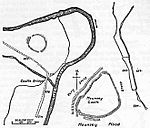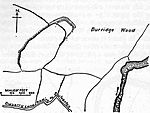Caratacus Stone

The Caratacus Stone, sometimes known as the Caractacus Stone, is an inscribed stone on Exmoor in Somerset, England. It is thought to date from the 6th century, and it has been a scheduled monument since 1925.The inscription, in Latin, appears to read CARAACI NEPVS, though experts have stated that a bar above the second A forms a ligature meaning that it should be read as CARATACI NEPVS. It is possible that there was more text on the stone that has weathered away.The inscription, which can be translated as "grandson or immediate descendant of Caratacus", has led to the general opinion that the stone was probably erected as a memorial to a person who claimed the first-century British chieftain Caratacus as an ancestor.The first mention of the stone was in 1219, when it was described in a perambulation of the Royal Forest of Exmoor as "the Langeston". In 1890 the letter N (which is reversed) was missing from the inscription, but by 1919 the missing piece had been found and was cemented back in place. In 1906 a shelter was erected over the stone, and an excavation in 1937 revealed that the stone was not associated with a burial site.
Excerpt from the Wikipedia article Caratacus Stone (License: CC BY-SA 3.0, Authors, Images).Caratacus Stone
Halse Lane,
Geographical coordinates (GPS) Address External links Nearby Places Show on map
Geographical coordinates (GPS)
| Latitude | Longitude |
|---|---|
| N 51.090527 ° | E -3.586698 ° |
Address
Caratacus Stone
Halse Lane
TA24 7JL , Winsford
England, United Kingdom
Open on Google Maps







